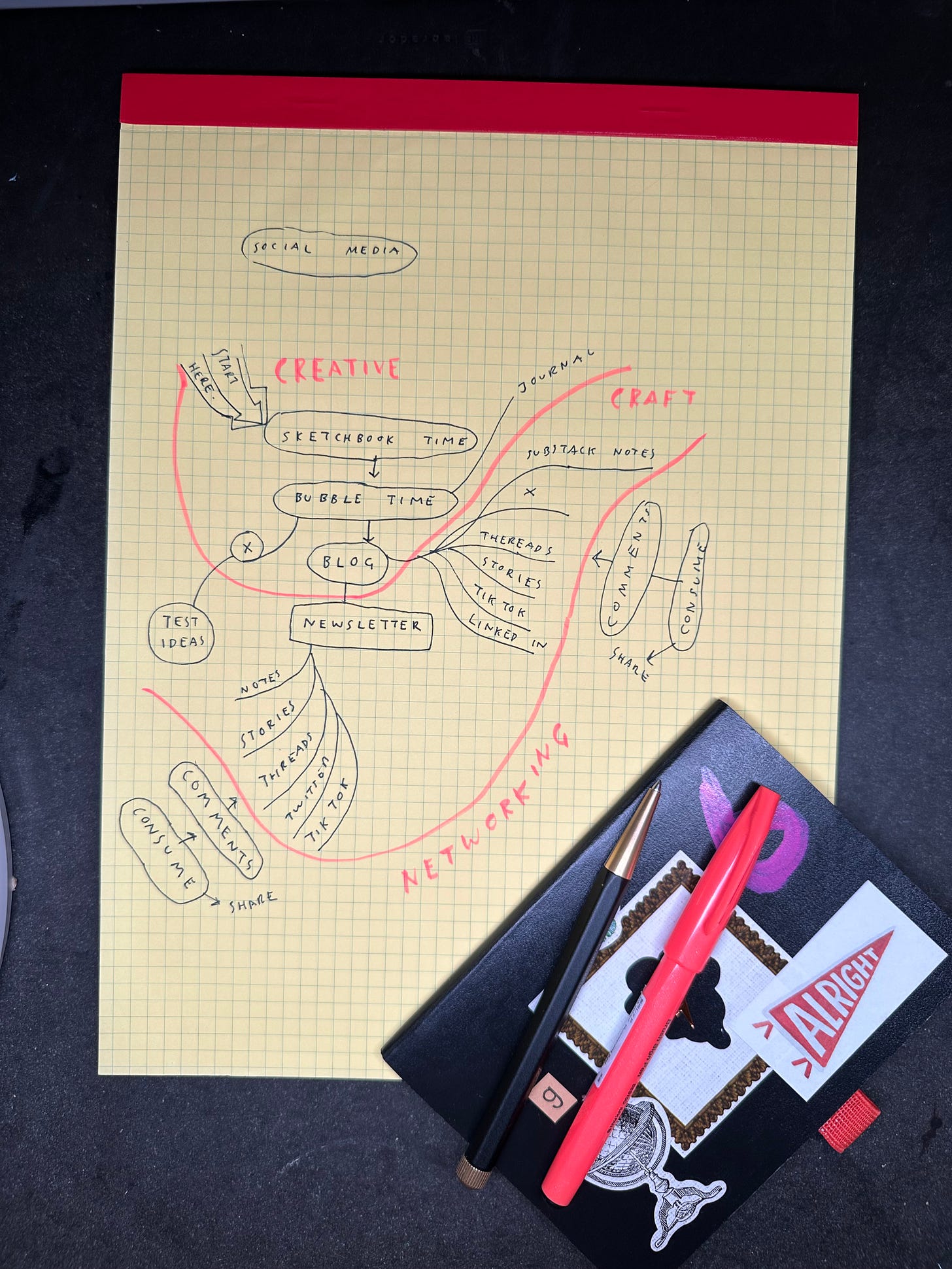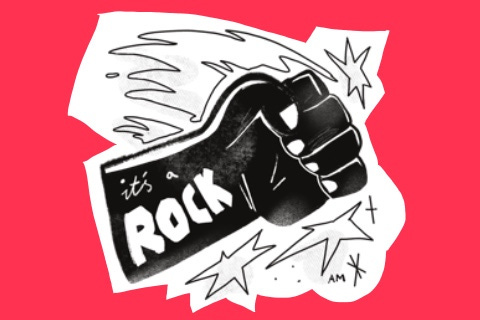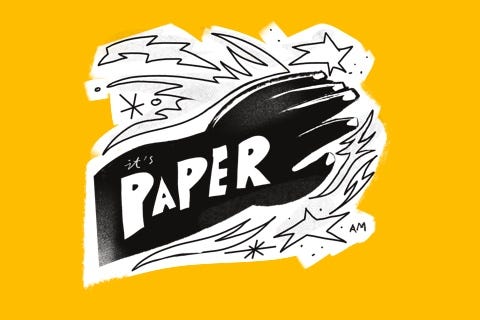The Illustrator's Social Media Survival Guide
A Three-Phase Approach to Thriving as an Illustrator in the Digital Age
Old Frame:
Social media is a necessary evil for illustrators. It's a time-consuming battleground where we constantly struggle to keep up with ever-changing algorithms, fight for attention, and hope for that viral post that might land us our next big gig. It's a place where our worth seems measured in likes and follows, often leaving us drained, uninspired, and questioning our creative value.
New Frame:
Social media is a powerful tool that, when approached mindfully, can amplify our creative voice and connect us with our ideal audience and collaborators. By separating our creative process from our online engagement, we can transform social media from a source of stress into a strategic asset. It becomes a curated showcase of our work, a platform for meaningful connections, and a launchpad for opportunities – all while preserving the sanctity of our creative time and energy.
My Fight with Social Media
As an illustrator I wrestle with social media daily.
It's my showcase and battleground. Social media amplifies my art, connecting me to fans and clients. It inspires but it also drains. Algorithms, impostor syndrome, and art thieves create a challenging environment where every post feels like a gamble.
Many illustrators quit social media but eventually return because the potential outweighs the cost. In this newsletter, I'll share my process of breaking apart the creative aspects of my practice from the promotional and networking aspects, offering a framework for navigating the social media landscape.
The Reality of Social Media for Illustrators
Benefits and Drawbacks
Social media offers unprecedented opportunities for illustrators to showcase their work, reach a global audience, and connect with potential clients. However, it also comes with drawbacks:
Time consumption
Algorithmic unpredictability
Pressure to constantly produce content
Comparison and impostor syndrome
Threat of art theft
The "Yuck" Factors: Promotion and Networking
There are two 'yuck' words many want to ignore in conversations about social media: Promotion and Networking.
I choose to tackle them head-on. By naming these parts of our creative practice, we can pull them out of the actual creative phase and handle them separately as the chores that they are.
A New Approach: Three Phases
Instead of the old frame of picking a social media platform and posting in hopes of scoring dopamine hits (likes), clients, and the occasional conversation, I propose a new frame: Decouple your efforts from platforms and split your practice into three distinct phases.
Phase 1: Creative Time
Build Creative Bubble Time
Time can't be made; it can only be taken. It can be taken from you or by you. I'm not a creative because I've illustrated 10 books. I am a creative because I take time to do creative work.
Building on a foundational practice of ten minutes a day for sketching or journaling, I allocate larger chunks of what I call "Bubble Time." This concept is inspired by Cal Newport's idea of "deep work," but with a creative twist.
Importance of Uninterrupted Creation
Bubble Time is an uninterrupted chunk of time to create in an intentionally ineffective way while being undisturbed. In this creative bubble, I'm not concerned with what the algorithm wants or what I'm going to put in my next newsletter. I'm just making things because I'm a person who makes things.
There is only one directive: Make Something. Beyond that, anything goes!
Phase 2: Crafting Promotions and Newsletters
Turning Creative Output into Promotional Material
Art is the byproduct of the creative process. The Creative Time produces artifacts: sketches, journals, blogs, and art. Now it's time to switch hats from an artist to a designer. Your role is to decide on the outcome you're looking for and design 'promotions' to help you reach that outcome.
Goals of Promotions
Some goals for my promotions include:
Testing new ideas with an audience
Getting illustration clients
Selling books
Promoting my Substack to new readers
Converting readers to paid subscribers
Building rapport in the creative community
Based on the intention of my social media 'promotion', I craft a call to action and create a caption connecting the outcome of my Bubble Time to the desired outcome.
The Value of Newsletters
A mailing list mitigates the problem of algorithmic control over who sees your posts. I see the newsletter as the next stage of a relationship that often starts on social media. To craft a newsletter, I consider our common goals and how I can provide value while staying true to my promise to subscribers.
Phase 3: Networking in the Comments
The Attention Economy of Social Media
We're on social media because we want attention. That means everyone you see on social media is also there for attention. Paying attention is how you get into the game, and because attention is so scarce, the things we choose to ignore unlock more time to pay attention to the important things.
Building Relationships and Alliances
Once you've read something meaningful, take a minute to express your gratitude or share an idea. Tell someone what you like about their tastes or their artwork. Over time, this might develop into something like a friendship or a creative alliance.
Rules for Effective Commenting
I have some rules for commenting:
1. Don't comment when drunk (or when your head isn't in the right place)
2. Don't whine
3. Don't pick fights with strangers
4. Celebrate other creatives and share their success
5. Read the post/caption before sharing or commenting
Conclusion
In the past two decades, social media has evolved from a playtime activity to a hyper-competitive industry. Promoting yourself on social media is a highly valuable skill, but it's not the only way to succeed as a creative.
The important thing is to have the Social Media spring out of the Creative Time and not replace it.
By separating these phases, we can maintain our creative integrity while still reaping the benefits of social media engagement. Authentic connections and quality work will always be at the heart of a successful creative career, regardless of the platform or medium.
How do You engage with Social Media in 2025
Have a hot take or want to start a longer discussion?
🏴☠️ Press the shiny, green button to unlock that secret treasure.








Your New Frame positioning is so money and really helped compartmentalize the current landscape in a way that resonates. I really struggle with Phase 2 as the Yuck factor is so high for me, I wonder if this decreases as one gets better at it. Overall, this post was super helpful as someone starting off and the challenges are real. I’m focusing on Phase 1 right now but the way you have so clearly and concisely illustrated Phase 2 & 3’s importance and how to mental prep provide helpful lampposts.
Side note: Are you a TPM or PMT in tech?? You definitely sound like someone who has the technical & strategizing skills to break down complex scenarios in clear and concise digestible chunks which are rare skills to come across. Kudos, am a fan of your mindset, writing, & strategic style.
Great message. I largely quit social media earlier this year, but have doubted the decision and still struggle over whether it was the right thing to do. Thanks for your take on it. Super helpful.